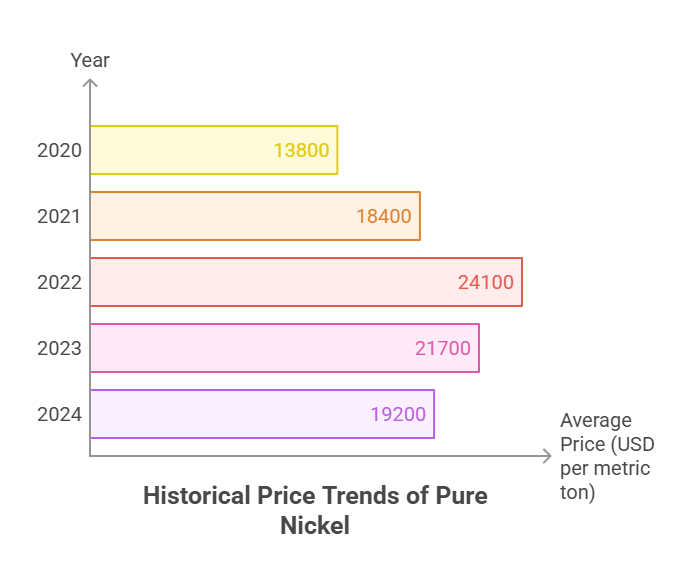Pure nickel is a highly sought-after industrial metal known for its excellent corrosion resistance, thermal stability, and magnetostrictive properties. It plays a crucial role in a variety of sectors, including electronics, aerospace, chemical processing, and battery manufacturing. This article provides an in-depth overview of the current and historical pricing trends of pure nickel, factors influencing its price, and what buyers should consider when sourcing this material.
What Is Pure Nickel?
Is Pure Nickel?
Pure nickel is typically defined as nickel with a minimum purity of 99.0% or higher, commonly traded in grades like Nickel 200 (UNS N02200) and Nickel 201 (UNS N02201). These grades differ slightly in their carbon content and are used in different industrial applications based on their mechanical and corrosion resistance properties.
Current Market Price of Pure Nickel
The price of pure nickel fluctuates daily based on global market trends. As of mid-2025, the average market price for pure nickel is between $18,000 and $20,000 per metric ton on the London Metal Exchange (LME), equivalent to approximately $8.16 to $9.07 per pound.
| Unit | Price Range (2025) | Notes |
|---|---|---|
| Per Metric Ton | $18,000 – $20,000 | Based on LME average |
| Per Kilogram | $18.00 – $20.00 | 1 ton = 1000 kg |
| Per Pound | $8.16 – $9.07 | 1 kg = 2.20462 lbs |
Historical Price Trends of Pure Nickel
Nickel prices have experienced significant volatility over the past decade, driven by demand from electric vehicle (EV) battery manufacturers and supply constraints from major producers like Indonesia and the Philippines.
| Year | Average Price per Metric Ton | Key Events |
|---|---|---|
| 2020 | $13,800 | COVID-19 reduced industrial demand |
| 2021 | $18,400 | EV boom drove demand higher |
| 2022 | $24,100 | Russia-Ukraine conflict disrupted supply |
| 2023 | $21,700 | Supply chain stabilization |
| 2024 | $19,200 | Increased Indonesian output |
Factors Affecting the Price of Pure Nickel
The price of pure nickel is influenced by a combination of economic, geopolitical, and industrial factors:
| Factor | Description |
|---|---|
| Supply Chain | Disruptions in major producing countries can cause price spikes. |
| Global Demand | Demand from EV, aerospace, and electronics sectors significantly affects pricing. |
| Stock Levels | Stockpile changes at LME and SHFE influence market sentiment. |
| Energy Prices | Mining and refining are energy-intensive; rising costs push nickel prices higher. |
| Trade Policies | Export bans or tariffs by nickel-producing nations alter global supply dynamics. |
Regional Differences in Pure Nickel Pricing
While the LME sets a global benchmark, local market conditions, tariffs, and shipping costs can lead to regional price differences:
| Region | Average Price (USD/lb) | Notes |
|---|---|---|
| North America | $8.50 – $9.20 | Includes processing and freight |
| Europe | $8.70 – $9.30 | Higher due to energy and logistics costs |
| Asia | $8.10 – $8.80 | Proximity to major producers reduces cost |
Forms and Purity Grades of Pure Nickel
Pure nickel is available in various forms and grades that may impact pricing depending on processing and application:
| Form | Typical Price Range (USD/lb) | Remarks |
|---|---|---|
| Nickel Plate | $8.20 – $9.50 | Common in electroplating |
| Nickel Sheet | $8.10 – $9.40 | Used in battery and aerospace sectors |
| Nickel Rod/Bar | $8.30 – $9.60 | Machined for fittings and fasteners |
| Nickel Wire | $8.50 – $10.00 | High precision applications |
Future Outlook for Pure Nickel Pricing
Market analysts predict that nickel prices will remain volatile in the near future, with a strong upside potential due to the global green energy transition. Demand from lithium-ion battery production is expected to increase by over 30% in the next three years, especially with the expansion of gigafactories in Asia and North America.
However, this may be offset by increased output from Indonesia, the Philippines, and emerging African nickel projects. Regulatory changes, environmental restrictions, and technological developments in battery chemistry (e.g., shift to lower-nickel chemistries) could also play a role in moderating prices.
Related Questions
What is the current price of pure nickel per pound?
The current price of pure nickel in 2025 ranges from $8.16 to $9.07 per pound, depending on form and region.
Why is nickel so expensive?
Nickel is expensive due to its critical role in high-performance alloys, electric vehicle batteries, and limited global supply chains, which are susceptible to geopolitical and environmental risks.
Which country produces the most nickel?
Indonesia is the world’s largest producer of nickel, accounting for over 30% of global production in recent years, followed by the Philippines and Russia.



